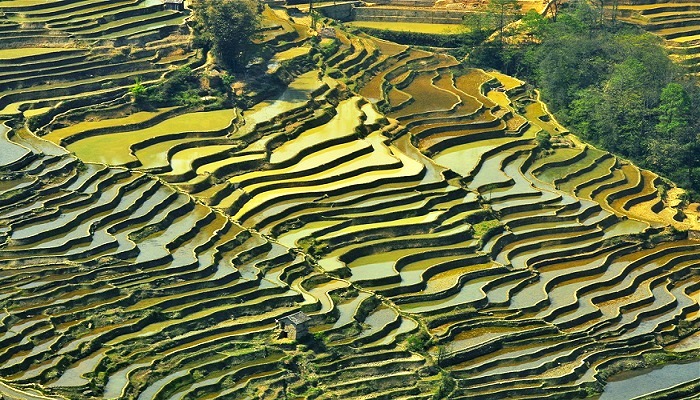Honghe Hani Rice Terraces
1,300 years ago the Hani tribe settled in this remote corner of southern Yunnan between the Hong River and Ailao Mountain, a beautiful but inhospitable landscape. Traditional farming was not possible on the steep mountain slopes that were sometimes near-vertical, but the ingenious Hani literally carved out a living here and worked out a highly-efficient system of irrigation and terraced farming that took the rest of the country centuries to cotton on to and copy for themselves.
Nowadays there are over 16,600 hectares of terraces, some of them 3,000 steps high, on which the Hani cultivate mostly red rice and raise buffalo, cattle, aquatic animals, ducks, fish, supporting their 82 ‘mushroom house’ villages. The Hani worship the natural world – the sun, moon, trees, water, fire – and could be said to represent the harmony between man and nature, with a lively culture of festivals, songs and music. The terraces are so carefully carved into the mountain and utilise every available inch of land and drop of water that a Ming emperor bestowed the title ‘skilful sculptors’ on the Hani tribe, and the landscape of emerald forests at the top of the mountain, ancient villages, shimmering pools of water on the slopes and the river below, all wreathed in clouds, has been recognised by UNESCO as a World Cultural and Natural Heritage site. It is hoped that this will increase efforts to improve the immense ecological and conservation benefits to the area and to encourage the preservation of the unique Hani culture, all of which are of course under threat from the rapid urbanisation and industrialisation of China.
Xinjiang Tianshan Mountain
Part of the Tianshan (“celestial mountain”) of Central Asia along the border of China and Kyrgystan, one of the largest mountain ranges in the world, is the newest addition to the UNESCO World Heritage list, a stunning range of massive snowy peaks, thousands of glaciers, forests, steppes meadows, plunging rivers and sheer canyons that eventually give way in the south and east to the spectacularly barren landscape of the Taklmakan desert. It is a land of extremes, of dramatic contrasts in landscapes, climate, ecology and wildlife. It is home to the endangered snow leopard, to wolves and ermine, mountain goats and sheep high up, to bears, wild boar, eagles and vultures in the forests and steppes, whilst on the lower deserts are antelope and gazelles. There is also a wide variety of ethnic groups, Han Chinese giving way to Mongols, Uighurs, Kazakhs, Uzbeks, as well as Russians, Jews, Ukrainians and Tartars who were forcibly relocated here by Stalin.












